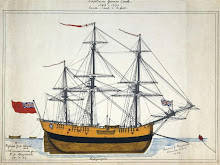In answer to Teresa's question about the flag history, Ed Cline sent her, in a separate email, a brief comment on colonial flags. I thought it was worth reproducing here:
Hi Teresa:
The history of the East India Company jack, or flag, as related by the blog host (and by me in the novels) is factual up to the time Steven Safford procured one in Louisbourg. What Jack Frake, Hugh Kenrick and the Attic Society, later the Sons of Liberty, did with what Safford brought back from that campaign is fictional. There is no record of what flags were flown by the Americans at Bunker Hill, just speculation and mentions in biographies. There is no record of Virginians foiling a landing of the hated stamps, either. However, the East India Company jack is a fact, and it may be seen over the sterns of East Indiamen in contemporary paintings. [There are some interesting pictures on this site: http://www.portcities.org.uk/london/server/show/ConGallery.69/The-Lords-of-the-Ocean-Ships-of-the-East-India-Company.html]
So, how did that jack develop into the Stars and Stripes of today? No one knows for sure. No history of the American flag even mentions the EIC jack, although it was obvious to me what its origin must have been, having gone onto the National Maritime Museum site in London in the course of my researches and seen the depictions of the East Indiamen. Omission of the jack in those histories startled me. But, by charter, East Indiamen were not permitted to call on North American ports. So no colonial American who had never voyaged to Britain would have ever seen one. Benjamin Franklin, however, spent a good portion of his life in London (later in Paris), as did many other colonial Americans, such as Arthur Lee. Immediately east of London Bridge on the Thames were the warehouses and docks of the East India Company, in the Pool of London, where the Indiamen loaded and unloaded cargoes. Franklin, Lee, and numerous other colonial Americans who crossed that bridge had to have seen the Indiamen and their jacks.
Someone who had lived in London -- it is not known who it could have been -- must have, at the beginning of hostilities between Britain and the colonies, suggested the jack design and alterations to it as either a simple means of symbolizing the thirteen colonies in the stripes -- and that idea is evident in contemporary prints of American flags featuring just the stripes with rattlesnakes and/or mottos -- or as a means of adopting in a spirit of defiance the fact that it was East India tea that was dumped into Boston Harbor in 1773, the first genuine physical resistance to Crown policies. (The EIC contracted with private merchant vessels to transport the tea to the colonies, since its own vessels were not permitted to sail there.) It might have been Franklin, or Lee, or any other American who was familiar with London.
This is my own hypothesis, but given the uniqueness of the jack's design and its similarity to flag designs adopted by Americans, it is a credible one. Up until Congress adopted the stars and stripes design as the official one, American armies marched under a bewildering mix of flags, and even after adoption, that remained the case.
Hope this helps.
Cheers, Ed
Thursday, September 10, 2009
More Sparrowhawk flag history
Subscribe to:
Post Comments (Atom)


No comments:
Post a Comment